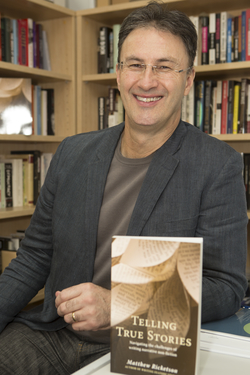Vanessa Lam
19 February 2015: One of the first lessons journalists are taught is to report the truth and nothing but the truth. However, when it comes to writing narrative non-fiction, reporters face many challenges such as reconstructing scenes and dialogue, maintaining trust with sources or how to use the narrator's voice.
University of Canberra professor of journalism Matthew Ricketson explores how to deal with these challenges in his new book Telling True Stories: Navigating the challenges of writing narrative non-fiction.

| |
|
Professor Ricketson said that what separates narrative non-fiction from other non-fiction writing is that it has the narrative elements usually associated with fiction: such as setting, voice/tone and character development, and engages readers on a deeper level.
"When it 's working well, narrative non-fiction has the authority of non-fiction and the artfulness of fiction. That makes for a potent combination," Professor Ricketson said.
"Telling true stories is a powerful form of public communication. Researching what is going on in people's lives and in the world around us unearths fresh – even revelatory – information, which at its sharpest will speak truth to those in positions of power and authority. "
Professor Ricketson's experience in truth-telling spans a 20-year journalism career working for a number of news organisations including The Age, The Australianand Time Australia magazine. In 2009 Professor Ricketson became the University of Canberra's first professor of journalism, before that he was the media and communications editor for The Age from mid-2006 to early 2009. He also previously ran the journalism program at RMIT for 11 years.
Professor Ricketson said that writing true stories has been his passion for 20 years, beginning in his early years as a young journalist reporting on the Ash Wednesday bushfires in 1983.
"What struck me most and what I still remember today is the gap between the enormity of the event and the means at my disposal to communicate it – a short news article, " he said.
"I really enjoyed trying to nut out some of the thorniest issues that come up when you are researching and writing true stories. In this book I hope I 've provided some kind of roadmap for those who write true stories – or want to."
His insights in the book not only focus on the challenges that arise from writing narrative non-fiction, but it also acts as a resource for anyone who is interested in telling true stories, whether it be journalists or authors. He analyses different techniques used by some of the best international practitioners from around the world and gives advice on how to produce authentic, vibrant and memorable writing. The book also looks at examples of influential narrative non-fiction, such as Truman Capote's In Cold Blood.
"A well-crafted true story explores events in their complexity and people in their full humanity," he said.
Telling True Stories: Navigating the challenges of writing narrative non-fiction is available as an e-book and in hard copy.


